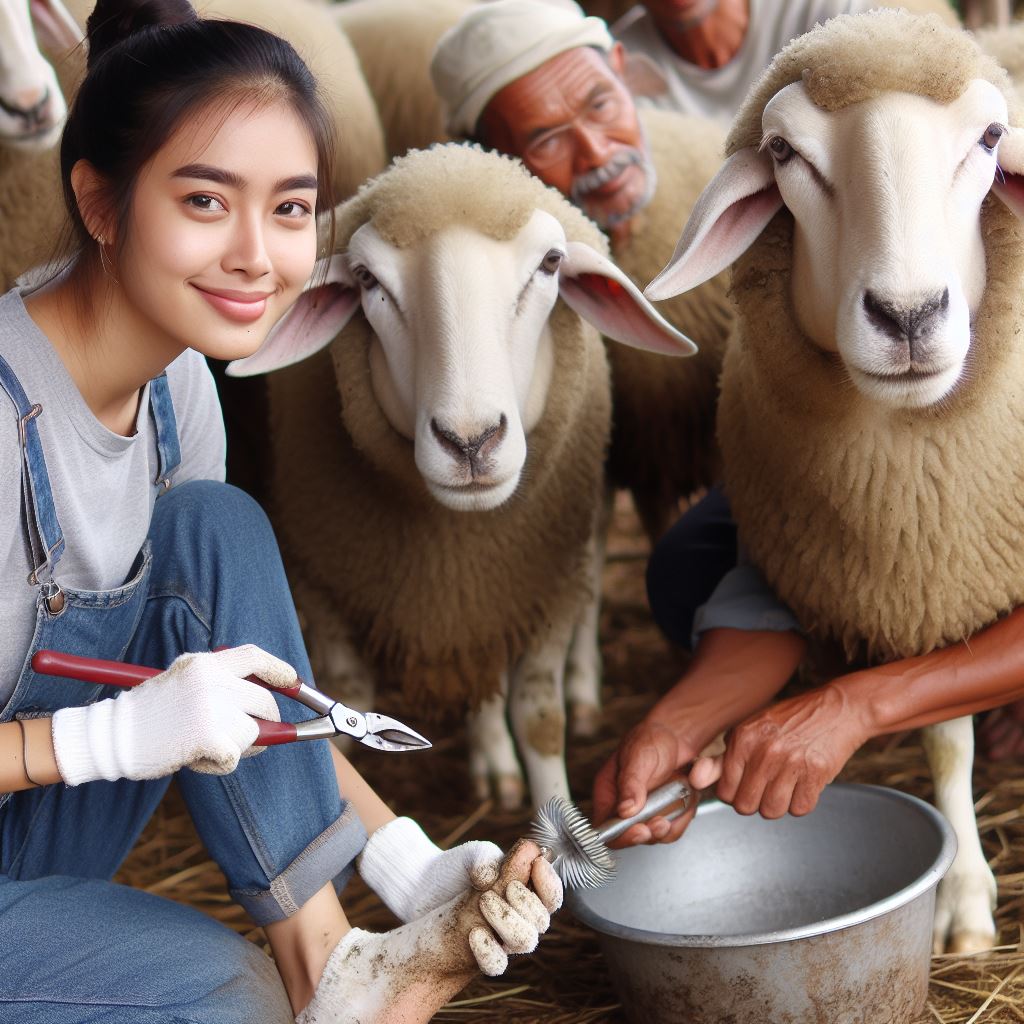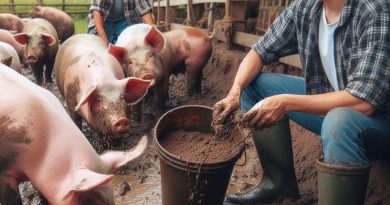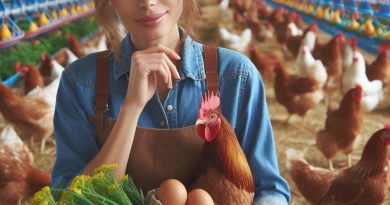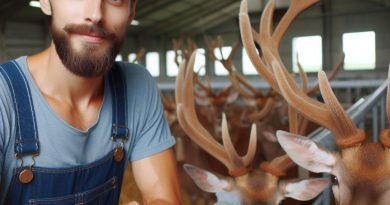Sheep Foot Care: Preventing Issues
Last Updated on February 5, 2024
Introduction
Proper sheep foot care is crucial for the overall health and well-being of these animals.
Sheep foot care is paramount for overall flock health.
Importance of Sheep Foot Care
Proper attention to hoof maintenance prevents lameness, a common issue affecting sheep.
Healthy feet are essential for sheep to graze, walk, and avoid pain or infections.
Neglected foot care can lead to lameness, loss of productivity, and even death in severe cases.
Regular Inspection and Cleaning
- Sheep owners should routinely inspect each sheep’s hooves for any signs of damage or disease.
- Clearing debris, mud, and manure from their feet will help prevent infections and discomfort.
Trimming Overgrown Hooves
- Hooves that become too long can cause pain, deformities, and difficulty in walking for sheep.
- Regular hoof trimming should be practiced to maintain the appropriate length and shape.
Addressing Common Foot Problems
- Foot rot, a bacterial infection, is a common issue that needs prompt treatment and proper hoof hygiene.
- Treating foot rot involves cleaning, medicating, and isolating affected sheep to prevent spreading.
Providing Suitable Housing and Flooring
- Housing should have dry and clean flooring, preventing accumulation of moisture and bacteria that can harm sheep feet.
- Proper flooring materials, like rubber or rubber-capped slats, protect hooves and promote good foot health.
Consider Nutritional Needs
Proper nutrition, including a balanced diet with adequate minerals and vitamins, helps maintain healthy hooves.
Consult with a veterinarian to develop a nutrition plan that supports strong feet and hoof growth.
The main objective of the blog post
The main objective of this blog post is to provide tips and strategies for preventing foot issues in sheep.
Essentially, Sheep foot care is crucial for preventing issues, ensuring the well-being and productivity of these animals.
By implementing regular inspections, cleaning, trimming, and addressing problems promptly, sheep owners can prevent foot problems
Understanding Sheep Foot Health
Anatomy of a Sheep’s Foot
Sheep have cloven hooves, consisting of two main parts: the hard outer hoof and the soft inner part.
The inner part, called the sole, is highly sensitive and contains numerous blood vessels and nerves.
At the back of the foot, there is a tough, triangular-shaped structure called the heel.
Between the toes, there is a small interdigital space known as the cleft, which can easily trap moisture and bacteria.
Understanding the anatomy of a sheep’s foot is crucial for maintaining its health and preventing issues.
The Role of Proper Foot Care in Overall Sheep Health
Proper foot care directly contributes to the overall health and well-being of sheep.
Regular foot maintenance helps prevent lameness and discomfort, ensuring sheep can graze and move freely.
By keeping their feet healthy, sheep are less likely to develop secondary issues like weight loss or decreased fertility.
It also minimizes the risk of infectious diseases, which can spread through infected lesions on the feet.
Common Foot Issues in Sheep
Foot Rot
Foot rot is a contagious bacterial infection that affects the tissues between the toes.
It causes swelling, lameness, and a foul odor. Wet and muddy environments increase the risk of foot rot.
Hoof Abscesses:
Hoof abscesses are painful pus-filled infections that normally occur due to bacterial invasion through small hoof injuries.
Sheep with hoof abscesses show signs of lameness, tenderness, and heat around the affected area.
Foot Scald
Foot scald, also known as interdigital dermatitis, is a highly contagious bacterial infection in the interdigital cleft.
It causes redness, swelling, and lameness. Moist and dirty living conditions contribute to foot scald.
Overgrown Hooves
Overgrown hooves can occur if sheep are not regularly trimmed or have limited access to abrasive surfaces.
The hooves can become long and curved, leading to discomfort, difficulty walking, and increased risk of other foot issues.
Taking preventative measures and providing proper foot care can significantly reduce the occurrence of these foot problems.
Regular hoof trimming, cleanliness, and avoiding wet and muddy conditions are vital in maintaining sheep foot health.
Read: Shearing Techniques for Sheep: A Guide
Preventive Measures for Sheep Foot Care
Regular inspections
Regular inspections are vital for preventing foot problems in sheep.
By closely monitoring their feet on a regular basis, potential issues can be identified and treated promptly.
Inspecting sheep feet can be done by farmers, or they can seek the help of a qualified veterinarian or a professional hoof trimmer.
The frequency of inspections depends on various factors, such as the weather conditions and the overall foot health of the flock.
Typically, it is recommended to inspect sheep feet at least once a month.
However, during periods of prolonged wetness or muddy conditions, more frequent inspections are necessary to mitigate the risks of foot problems.
Proper nutrition
Proper nutrition is another critical aspect of sheep foot care.
A balanced diet is essential to maintain optimal foot health.
Adequate levels of essential nutrients, such as zinc, copper, biotin, and protein, should be provided through their diet.
These nutrients contribute to the strength and integrity of the hooves, reducing the likelihood of foot issues.
Clean and dry living environment
Maintaining a clean and dry living environment is crucial for preventing foot problems in sheep.
Excessive moisture and dirt can create a favorable environment for the growth of bacteria and fungi, leading to infections.
Proper drainage in the sheep’s living area should be ensured to prevent the accumulation of water or mud.
Regularly removing any mud or manure from the area will help keep the feet dry and clean.
Farmers can also take additional measures to protect their sheep’s feet.
Providing a clean and dry bedding area can reduce the risk of foot problems.
Bedding materials, such as straw or wood shavings, should be regularly replaced or supplemented to maintain cleanliness and dryness.
Additionally, keeping the grazing areas well-managed and avoiding areas with excessive mud or standing water can also contribute to better foot health in sheep.
Overall, preventative measures are crucial for ensuring the foot health of sheep.
Regular inspections, proper nutrition, and a clean and dry living environment all play significant roles in preventing foot problems.
By implementing these measures, sheep farmers can reduce the occurrence of foot issues and promote the overall well-being of their flock.
Read: Top Feeding Tips for Healthy Sheep
Trimming and Maintenance Practices
Importance of regular hoof trimming:
- Enhances overall hoof health and prevents various foot issues.
- Improves sheep mobility and reduces the risk of lameness.
- Allows early detection of potential problems and quick intervention.
How to trim sheep hooves safely
Tools needed for trimming
- Hoof shears or trimmers with sharp, clean blades.
- Hoof pick for cleaning dirt and debris.
- A sturdy hoof stand or restraint device.
- For larger flocks, an electric grinder or rotary rasp can be efficient.
Step-by-step instructions for trimming
- Select a clean and well-lit area for hoof trimming.
- Gently restrain the sheep using a hoof stand or restraining device.
- Carefully pick out any dirt or debris from the hoof with a hoof pick.
- Identify the overgrown parts of the hoof that require trimming.
- Hold the hoof between your knees, securely but not too tight.
- Using sharp trimmers, gradually remove the excess hoof material.
- Trim the hoof in small increments to avoid cutting into the sensitive tissue.
- Smooth the edges of the trimmed hoof with a rasp or grinder.
- Inspect the hoof for any signs of infections, cuts, or abnormalities.
- Release the sheep and repeat the process with the remaining hooves.
Frequency of hoof trimming
The frequency of trimming depends on various factors such as:
- The breed of sheep (some breeds require more frequent trimming).
- The diet and terrain the sheep are exposed to (grazing on rougher terrain may naturally wear down hooves).
- The season (hooves tend to grow faster in warmer, wetter conditions).
- As a general guideline, sheep hooves should be examined and trimmed every 6-8 weeks.
- Regularly check hooves in between trimmings for any signs of overgrowth, infections, or lameness.
- Adjust the trimming schedule accordingly to ensure optimal foot health and prevent issues.
By diligently following proper hoof trimming and maintenance practices, sheep owners can ensure the well-being and livelihood of their flock.
Regular trimming promotes overall hoof health, reduces the risk of lameness, and enables early detection and intervention of potential foot issues.
By using the right tools, following step-by-step instructions, and trimming at appropriate intervals, sheep hooves can be kept in optimal condition for their mobility and overall comfort.
Remember, a healthy flock starts from the ground up!
Read: Sheep & Goat Vaccination Schedules

Identifying and Treating Common Foot Issues
Footrot
Foot rot is a contagious bacterial infection that affects the feet of sheep and is caused by wet and muddy conditions.
To prevent foot rot, ensure clean and dry bedding, practice proper hoof hygiene, and avoid overcrowding.
Treatment options for foot rot include trimming infected tissue, applying topical antibiotics, and administering systemic antibiotics if necessary.
Hoof abscesses
Hoof abscesses are painful infections that occur when bacteria enter the hoof through a crack or puncture.
Preventive practices for hoof abscesses include regular hoof trimming, maintaining clean and dry environments, and providing proper nutrition.
Treating hoof abscesses involves soaking the affected foot in warm water, applying poultices, and administering pain relief medication if needed.
Foot scald
Foot scald is a bacterial infection that affects the skin between the sheep’s toes and is caused by damp and dirty conditions.
Preventive measures for foot scald include keeping the barn clean and dry, providing proper drainage, and avoiding overcrowding.
Treating foot scald may involve applying topical treatments like copper sulfate or antibiotic sprays and isolating affected animals.
Overgrown hooves
Overgrown hooves can lead to lameness, discomfort, and other foot problems in sheep.
To prevent overgrown hooves, regularly inspect and trim the hooves, provide a balanced diet, and ensure adequate exercise.
Addressing this issue requires proper hoof trimming techniques, removing excess hoof material, and monitoring the sheep’s hoof health regularly.
Read: Wool vs. Hair Sheep: What’s Best?
Conclusion
Recap the importance of sheep foot care
Sheep foot care is crucial to prevent issues and maintain the overall health of the flock.
By regularly trimming hooves, managing grazing areas, and monitoring for signs of lameness, sheep owners can prevent foot problems.
The preventive measures discussed
Preventive measures include vaccination campaigns, promoting hygiene practices, and implementing social distancing measures.
Mask-wearing, hand hygiene, and respiratory etiquette remain crucial.
Public awareness and education efforts focus on fostering a collective responsibility to curb the spread of diseases, fostering a resilient and healthier society.
Prioritizing foot care will not only reduce the risk of lameness but also increase the productivity and profitability of the sheep operation.
Encouragement to prioritize foot care for their sheep
Regular inspections, proper hoof trimming, and maintaining clean living conditions are essential.
Healthy feet lead to overall vitality, ensuring your flock’s happiness and productivity.


